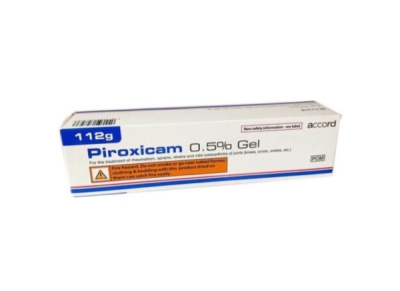Piroxicam gel is an effective non-steroidal anti-inflammatory drug (NSAID) used to treat pain and inflammation at the source. NSAIDs work by targeting the pain at the site and reduce inflammation.
When piroxicam is applied to the skin as a gel, instead of it having an effect on all of your body, it only works on the area where you have applied it. It is absorbed into your skin and then moves deeper into areas of your body where there is inflammation (for example, your muscle). Using a topical gel means that the total amount of piroxicam in your body remains low. This in turn means that you are much less likely to have a side-effect to the medicine. Topical anti-inflammatories like piroxicam are prescribed for adults - they are not generally suitable for use by children.
Pirxicam can be applied short term up to three times a day. It’s also safe to use with paracetamol and therefore can be used to treat any breakthrough pain that you may encounter during the day. Piroxicam should only be used for short term pain relief and if you find that you are using it for more than 28 days you should consult your GP for an alternative or for further advice.
In the event you miss a dose, it is safe to apply the missed dose as soon as possible. However, if enough time has passed that you should be applying your next dose instead, simply skip the missed dose and resume your typical application schedule.
Follow the instructions below to ensure appropriate use of this medication:
- Apply a thin layer of the gel and gently massage it into the affected area.
- Wash your hands well after using the gel (unless you've applied it to treat your hands).
It is also not suitable for use on or around the face, eyes or mouth and around the genitalia or rectum.
Always use this medication exactly as your clinician has told you. Check with our clinical team or your GP or pharmacist if you are not sure.
Medicines and their possible side effects can affect individual people in different ways. The following are some of the side effects that are known to be associated with this medicine. Just because a side effect is stated here, it does not mean that all people using this medicine will experience that or any side effect.
Common side effects include:
- Local Irritation at application site including redness and itching
- Photosensitivity (sensitivity to sunlight) where the application area becomes more susceptible to sunburn
For full information on side effects and correct use, see the patient information leaflet. If any side effects concern you, or you are experiencing any of the side effects mentioned in the patient information leaflet whilst taking this medication, please contact our clinical team or speak to your GP.
You should not use piroxicam if you are allergic to it, or if you have ever had an asthma attack or severe allergic reaction after taking aspirin or an NSAID.
Piroxicam can increase your risk of fatal heart attack or stroke, even if you don't have any risk factors. Do not use this medicine just before or after heart bypass surgery (coronary artery bypass graft, or CABG).
Piroxicam may also cause stomach or intestinal bleeding, which can be fatal. These conditions can occur without warning while you are using piroxicam, especially in older adults.
Tell your doctor if you have ever had:
- Heart disease, high blood pressure, or if you smoke
- A heart attack, stroke, or blood clot
- a stomach ulcer or stomach bleeding (especially while using an NSAID);
- Liver or kidney disease
- Asthma
- If you take aspirin to prevent heart attack or stroke
Piroxicam is not recommended for use during pregnancy, particularly in the third trimester, because if it is absorbed into the bloodstream in sufficient amounts it could have adverse effects on a developing baby.
Although the absorption of this medicine into the bloodstream is very low, the manufacturer does not recommend using it when breastfeeding because its safety has not been fully established.
Get emergency medical help if you have signs of an allergic reaction to this medication. These include:
- Hives
- Dizziness
- Fast or pounding heartbeats
- Wheezing
- Difficult breathing
- Swelling of your face, lips, tongue, or throat.
It is important that you let us know which prescription, over-the-counter medicines and recreational drugs you are currently taking. You must also tell us about any other medical conditions that you currently have (or had in the past). This will help us ensure the prescribed medication is safe and appropriate for you to take.
For full information on warnings, medication interactions and contraindications, refer to the Patient Information Leaflet. Please read all packaging and the Patient Information Leaflet before taking any new medicine and inform our clinical team or your GP of medicines you are taking or intend to take.







